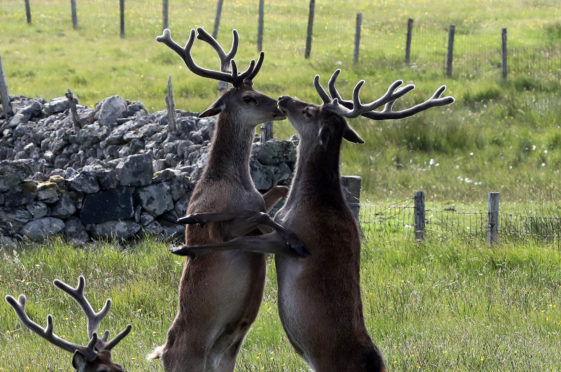An Isle of Lewis resident captured this unusual image of two red deer stags apparently “hugging”.
Gordon Macrae came across a small group of young stags on the west side of the island and was able to capture the moment from a distance of around 50 paces.
Mr Macrae is deputy head teacher of Stornoway primary school, and likes to spend his spare time out with his Canon 5D photographing wildlife, particularly red deer.
He said: “I was downwind of them, and had my 400mm lens ready. The two stags walked down towards each other, rose up and stood like that for a while, no aggression at all.
“They seemed very happy to see each other.
“Stags often rise up on their hind legs and box with their front legs.
“This pair just hung onto each other and had a hug.”
Charles Smith-Jones, technical adviser at The British Deer Society praised the photo, but did not agree with the idea that the stags were hugging.
He said: “At this time of year when stags are producing their new antlers, the new growth is very sensitive and they are careful not to damage it.
“So, instead of using their antlers for asserting themselves, they will ‘box’ with their front hooves.
Local and Proud: Follow our new Facebook page dedicated to the Highlands and Islands
“This is often little more than play fighting or gentle bickering but can be rather more aggressive at times.
“The furry skin called ‘velvet’ which covers the growing antler is clearly visible in the photograph.
“Later on, when the antlers are no longer composed of living tissue but have become dead bone, the velvet is rubbed off and the antlers provide an important means of establishing dominance during the rut.
“This takes place in the autumn with a far greater likelihood of serious fighting.
“Red deer hinds will box as well- this helps them to establish pecking orders within the herd.”
Mr Macrae’s hobby has enabled him to capture other unusual sights, including an osprey, almost unheard of in the islands.
He said: “I was in the South Lochs area around Loch Shell last week when I saw it.
“I have never before seen one here, so I sent the picture to the RSPB who confirmed it was an adult osprey, and very rare indeed in these parts.”
